Try the supermarket downshift: Save £520 a year with one small change
If you consider yourself a cash-strapped student, yet you're feasting on Tesco Finest Parma ham and M&S brie, you're doing something wrong.
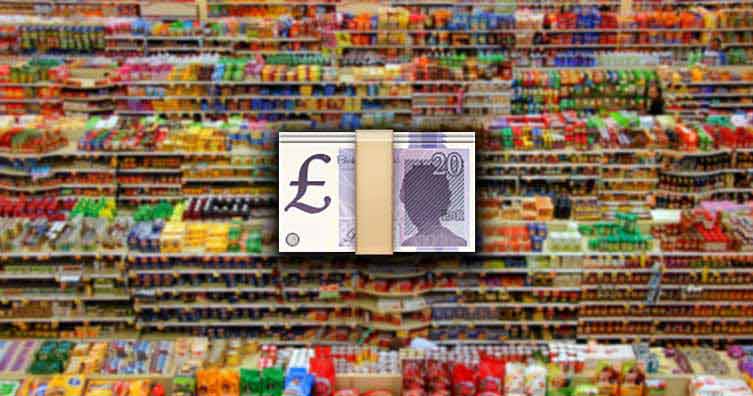
Your years spent surviving on a Student Loan budget is the prime time to discover the art of supermarket downshifting. If you swap your luxury buys for cheaper alternatives, you'll knock a shedload off the cost of your shopping basket.
By using the supermarket downshift mentality the next time you shop, you can save around a third of your weekly food spending. So if you normally spend £30 a week on food, you can cut that down to roughly £20. That's a saving of £520 a year!
Read on to discover how to do the downshift yourself, from a small jump to a huge saving.
What's in this guide?
What is supermarket downshifting?
The supermarket downshift method is based on the premise that supermarkets stock four different price levels of their staple products, with the most significant difference between the products not being the quality, but the price tag.
The four levels are:
- Premium brand – Luxury & organic brands such as Tesco Finest or Sainsbury's Taste the Difference.
- Manufacturer's brand – The brands we know and love – Heinz, Birds Eye, Walkers...
- Supermarket own-brand – Supermarkets' own versions of our favourite brands, such as Tesco cornflakes. Compare prices in our guide to the best own-brand alternatives.
- No-frills value products – Economy packets with basic packaging, for example, Asda Just Essentials apples or Sainsbury's Basics bread.
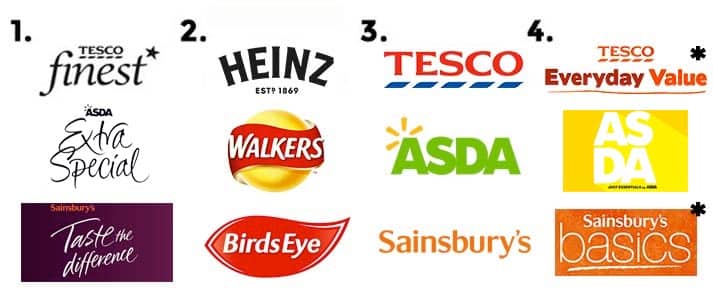
* Tesco and Sainsbury's have shifted a lot of their no-frills to some more farm-y sounding brand names, like Stockwell & Co. and Hearty Food Co. at Tesco, and Hubbard's Foodstore and Just Snax at Sainsbury's.
More often than not, the only noticeable difference between these brands is the packaging. On top of that, supermarkets will trick you into reaching for the more expensive packet by placing these products at eye level (and that's not the only trick they use, either).
It's also worth noting that the top two tiers may switch around – sometimes the branded product is even more expensive than the luxury brand. But either way, the principle remains: you should try to move down at least one pricing tier as part of the downshift.
Do you need to downshift everything?
Trading down to a shopping basket full of no-frills alternatives can be a massive ask for some people. If you can't bear the thought of parting with your Heinz ketchup, that's ok!
As long as you try downgrading on some items that are less important to you, such as washing up liquid, cooking oil, sugar and chopped tomatoes, you'll still make a substantial saving.
These are all basic student staples where the supposed drop in quality won't make a difference to your life in the slightest, but the drop in price will.
How much can you save with the supermarket downshift?
Just in case you don't believe us, we've decided to illustrate the point by comparing some standard student essentials within the same supermarket:
-
Pasta savings at Tesco
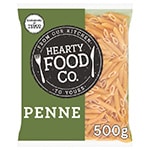
Premium – Tesco Finest Penne Rigate 500g: £1.70
Manufacturer's – Napolina Penne Pasta 500g: £1.50
Supermarket's Own – Tesco Penne Pasta 500g: 69p
No Frills – Hearty Food Co. Penne Pasta 500g: 41p.
By switching from Tesco's premium brand to their value pasta (Hearty Food Co.), you can save £1.29, meaning you can afford to test out a few more of our delicious pasta recipes.
-
Cheaper cheese at Asda
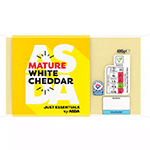
Premium – Exceptional by Asda Extra Mature Cheddar 300g: £3.50 (£11.67 per kg)
Manufacturer's – Cathedral City Mature Cheddar Cheese 350g: £3 (£8.57 per kg)
Supermarket's Own – Asda British Extra Mature Cheddar Cheese 400g: £3.00 (£7.50 per kg)
No Frills – Just Essentials by Asda Mature White Cheddar Cheese 400g: £2.49 (£6.22 per kg).
Cheese is one of those things that you don't realise is so expensive until you go to uni.
But at £6.22 per kg, Asda's no-frills cheddar is almost half the price of their Premium brand, and still comfortably cheaper than the manufacturer's version too. Easy peasy, very cheesy.
-
Bargain bread at Sainsbury's
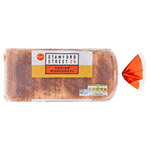 Premium – Sainsbury's Taste The Difference Soft Multiseed Farmhouse Thick Sliced Wholemeal Bread 800g: £1.40
Premium – Sainsbury's Taste The Difference Soft Multiseed Farmhouse Thick Sliced Wholemeal Bread 800g: £1.40Manufacturer's – Kingsmill Tasty Wholemeal Medium Bread 800g: £1.30
Supermarket's Own – Sainsbury's Thick Sliced Wholemeal Bread 800g: 75p
No Frills – Stamford Street Co. Medium Wholemeal Bread 800g: 47p.
Toast is every student's comfort food, and saving 93p on every loaf you buy will save you loads in the long run.
-
Stone-cold bargain ice cream at Waitrose
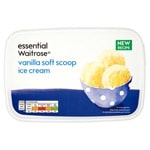 Premium – Waitrose No.1 Madagascan vanilla ice cream 500ml: £4.25 (85p per 100ml)
Premium – Waitrose No.1 Madagascan vanilla ice cream 500ml: £4.25 (85p per 100ml)Manufacturer's – Carte D'Or Madagascan vanilla ice cream 900ml: £4.10 (45.6p per 100ml)
Supermarket's Own – Waitrose vanilla dairy ice cream 1l: £3.50 (35p per 100ml)
No Frills – Essential Waitrose vanilla soft scoop ice cream 2l: £2.20 (11p per 100ml).
Downgrading a few levels on everyone's favourite dessert is a great way to save. Ice cream is ice cream as far as we're concerned, so you won't notice the difference. Plus, a saving of around 74p per 100ml is amazing.
Tips for saving with the supermarket downshift
So you're up for trying the supermarket downshift? Here are a few additional tips to ensure that you're working that downshift like a boss:
- Taste test no-frills products – Some supermarkets do no-frills brands better than others, so it's a good idea to do the rounds of different supermarkets sampling your favourite staples. Keep a shopping diary and rate products out of 10 to remind yourself what tastes best, and where.
- Use your judgement – Whilst store cupboard staples are perfect options for downshifting to a supermarket's own brand, you might not want to compromise on the likes of fresh meat. Just make sure you choose which products you downshift wisely.
- Downshift to a budget supermarket – Supermarkets like Lidl or Aldi can offer some serious savings, as they're almost entirely stocked with budget brands you've probably never heard of (but which taste just as good!). Beware that your Heinz won't be cheaper here, though, as manufacturer-branded products are generally the same price as in other supermarkets.
- Do the maths – Never assume that a supermarket's own brand value will undisputedly be the cheapest option. Sometimes supermarkets will have good deals running which mess up the whole downshifting theory. In some circumstances, you can actually find luxury products selling for the same price as no-frills.
Are you savvy to the dirty tricks that supermarkets pull to try and get you to spend more cash?








